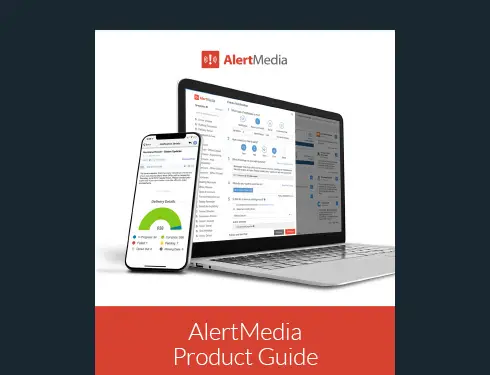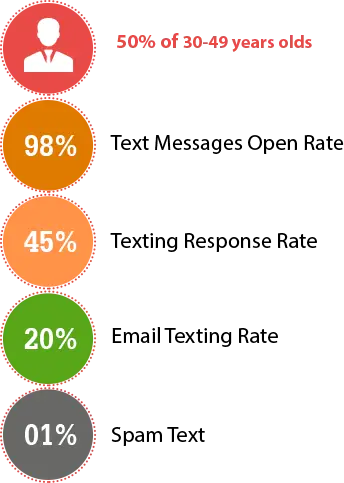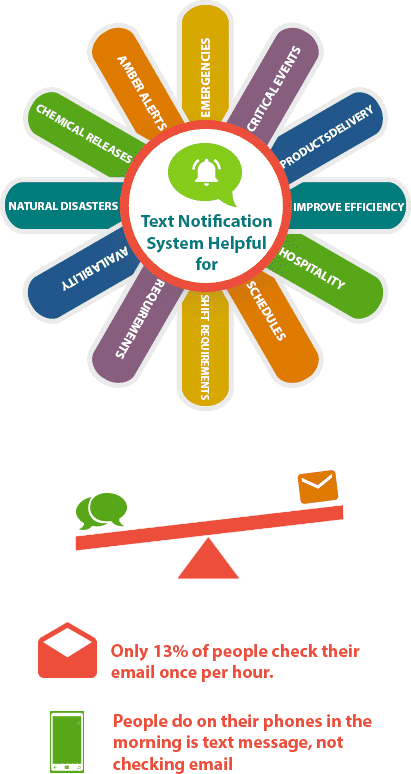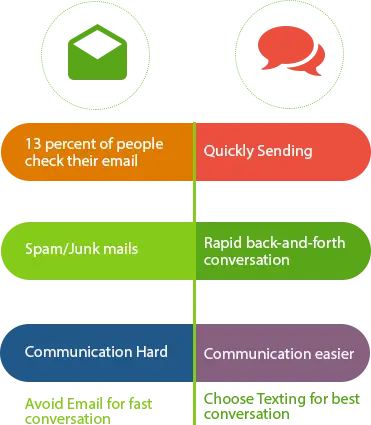
Does Your Communication Strategy Include a Text Notification System?
What can you do with one?

The Age of Technology
One of the greatest benefits of modern technology has to be the fact that we can find and do virtually anything on our mobile devices. It has connected us to each other and information in ways no one could have imagined even 20 years ago. What shows our age more than wrinkles or gray hair? What we used 20 to 30 years ago to do tasks compared with the technology our younger counterparts use today.
Our children may never know what a dial tone sounds like, how to use the Dewey Decimal System, what a VHS cassette was used for, or how to refold a map.
Everything they need to communicate with each other, find products, services, and information, get from point A to point B, and locate virtually any movie that has ever been made can be accomplished from a mobile device from nearly anywhere on the planet in less than a minute – and those capabilities are just scratching the surface of possibilities.
The History of Communications
If we focus on just a single aspect of this technology, namely communication, we can see just how far we have come. Messages and information used to travel from person to person via messengers on horseback, taking weeks to months to deliver. Then the printing press was invented by Johannes Gutenberg around 1440 which enabled mass messaging for the first time.
As people began to better understand the science of electricity and how it could be transferred from one location to another, inventors experimented with the possibility that the same principle might be applied to communication. Instantaneous communication was thus born. Samuel Morse invented the first electric telegraph in 1837. Alexander Graham Bell leveraged that technology to extend the capability to voice calls when he invented the telephone in 1876.
It was nearly one hundred years later until anyone made any real strides in communication and that came in 1972 when the first email was sent by Ray Tomlinson. Since its humble beginnings, email has become a mainstay for one-third of humans on earth. In fewer than fifty years since its inception, there are estimated to be 2.5 billion email users worldwide today.
Technology Is Driving Communication Channels
Email has completely transformed how we communicate in our personal lives, but even more so in our workplaces. We can hardly recall a time without computers and email or how we ever accomplished much of anything without them.
Remember interpersonal mail? If you needed to send a document to a coworker in a different location, you would put the document into a large folder, wrap a string around a cardboard disk to seal the envelope, then write the recipient’s name and location on one of the many lines printed on both front and back of the envelope. The envelope would go into a bin and a few times a day, perhaps, a carrier would collect the bin and deliver the envelope to the intended office locations. Mail sorters in those locations would file the envelopes into employee mailboxes or hand-deliver them if you were lucky. This took time, resources, and money.
We can laugh at the inefficiency of it all now because we have something infinitely more rational with which to compare it. At the time, however, we thought it was a good system for communicating and exchanging documents with coworkers in different locations. Email was not only a more viable option that was quickly adopted, it negated the need for those envelopes altogether.
The Challenges of Email
Email has also been a relatively new way to reach a large number of people via mass distribution lists. We can custom build a list of email addresses to specify a particular group we want to send our message to. This is a fantastic benefit of email but it also has its drawbacks.
Mass emails are often filtered as spam and may never be received. Even though email has been used for forty years, some people are still unfamiliar with email etiquette, namely replying only to the original sender of the email instead of replying to “all” in a distribution list. This leads to another huge problem with email – too much of it.
Our inboxes are flooded daily with messages from virtually every acquaintance we may have. It can be challenging for most of us to read all of them. Many end up in the deleted bin, junk file, or worse, continue to overload our inboxes as “unread messages” that constantly remind us of how far behind we are. We have all suffered from email overload.
Email also takes time. Depending on what device we use to access our email, we may be required to log in and wait for messages to download. We see a subject line and perhaps a preview of the message but then must click to read it in its entirety. Documents or photos are often attached, taking more time to download which can delay new emails from being received. Email is also loaded with spam and junk mail we must sort through to get to what really matters.
Of course, this is all relative. Email is still a giant leap from interoffice mail. However, when the downsides of technology are realized innovation is sparked. New and improved technology is always on the horizon.
Texting Takes Center Stage
What could possibly be better than email in certain circumstances? Texting. Texting is the fastest and easiest method of sending and receiving communications. Maybe that is why millennials prefer texting over all other forms of communication. Nearly two-thirds of them and 50 percent of 30- to 49-year olds use it as their primary mode of communication.
Texting takes all of the fluff out of oral conversation and email pleasantries. There is no need to begin a text with the typical “hello” and “how are you.” With texting, you can get straight to the point and the delivery of your message is instantaneous. If the message is concise enough the recipient doesn’t even have to open their phone but can read the pop-up message in a short glance. There is no login, no downloading, no inbox.
Texting is changing how businesses communicate as well.

Some companies are dumping voicemail altogether and others are implementing more texting into their communications and management practices. It is an affordable, efficient, real-time communication channel that provides more successful delivery outcomes. These outcomes can be measured and prove texting is highly effective.
In fact, text messages have a 98 percent open rate compared with email’s 20 percent open rate, and only one percent of texts are considered spam. Texting also has a 45 percent response rate, while email has only six percent. Those are statistics no company can afford to ignore.
The Benefits of Texting
Organizations are using texting for more than interpersonal communication or even communication with consumers, partners, and suppliers. They are using it as a mass communication system to keep employees safe during critical events, manage logistics with drivers and fleets, organize shifts and scheduling, and bring efficiencies to operations. Texting is an easy way to reach and communicate with people with real-time messages. It is the closest thing to a group huddle, an “all hands on deck” gathering, or an in-person meeting you can have while still being physically dispersed.
Text notifications can come in many flavors. The beauty of text message alerts is that they are flexible and can be configured however a company determines is best for its specific needs and the circumstances at hand. For example, during an emergency, not every employee may be in danger. Their office location or even where they are located within a facility may make them more or less vulnerable. A solid text notification system will enable the administrator to segment the organization’s employee base by location so texts are sent only to the people who need the information.
Texts are best when they are concise but are not limited to the information they can provide. By embedding links to additional instructions or information, texts can give as little or as much detail as required. A text notification system can be designed to provide only one-way messaging from administrators to employees, or bi-directional messaging where employees can reply to text messages.
Offering employees a way to respond to administrators and other employees can give administrators and security leaders ground-level insight into what is actually happening on the front lines. This information can help guide strategy and may provide critical eye-witness accounts that can save lives during an emergency.
Practical Uses for a Text Notification System
Texts can also be used for many other business purposes besides emergencies or critical events. Companies that manage large fleets of trucks and drivers must reliably deliver products to multiple locations, often across the country. By using text notifications dispatchers can communicate quickly with their many mobile drivers about real-time issues. Traffic delays, truck breakdowns, and warehouse problems may impact delivery times. With a text notification system, companies can receive timely information that can be passed along to customers and suppliers to boost customer service and improve efficiency. Text notification systems can also be used to keep drivers safe in dangerous situations.
Medical, manufacturing, hospitality, and restaurant industries use text notifications to manage shifts and schedules more efficiently. Some text notification software will integrate with internal scheduling systems to provide instant access to employee information, calendars, shift requirements, and availability and enable texts to be used to ensure everyone is where they should be when they are scheduled.
How are other organizations using their text notification systems? Many cities offer emergency notification texting during natural disasters, chemical releases, Amber Alerts, and other emergency situations. These texts are an improvement over voicemails or emails because they can get to the intended recipient faster. Even though most of us carry our mobile phones with us everywhere we go, we are not checking our email as frequently as we check texts. Only 13 percent of people check their email once per hour. One study found the first thing people do on their phones in the morning is text message, not check their email, which was reported as the most popular answer in 2014.
School districts are implementing texting as a way to provide timely communication to parents and staff about attendance and emergencies. Most airlines are offering travelers the option to be notified by text about flight delays, boarding times, baggage claim locations, and connecting flight information.

The Department of Homeland Security is developing technology that monitors flood sensors that trigger customized text alerts to people in harm’s way. Some states are using text notifications to warn crime victims and witnesses when an inmate is transferred or released. Penn State has even piloted a “laundry notification system” to send text messages to students when their load of laundry has finished washing or drying.
Will Texting Replace Email?
Even with all of the benefits of texting, email is not going anywhere anytime soon, particularly when it comes to our workplace. Texting is best for quickly sending and receiving short messages or information. It is fantastic for a rapid back-and-forth conversation. It is ideal for reaching people with critical information and instructions.
Email, however, may be best for sending and receiving documents, in-depth explanations, and more formal communications. Email clients enable users to create folders to manage emails, and have spam and junk mail filters to prevent many unwanted messages from coming into our inboxes. They also allow a user to set up multiple accounts, all of which are easily managed from a single screen.
When it comes to relaying emergency information to the masses, however, nothing yet replaces a text notification system. Texting makes instant communication easier in almost every environment, whether in emergencies or simply managing a business. Take a look at your options and see what creative ways your company can implement texting into its communication strategy.


